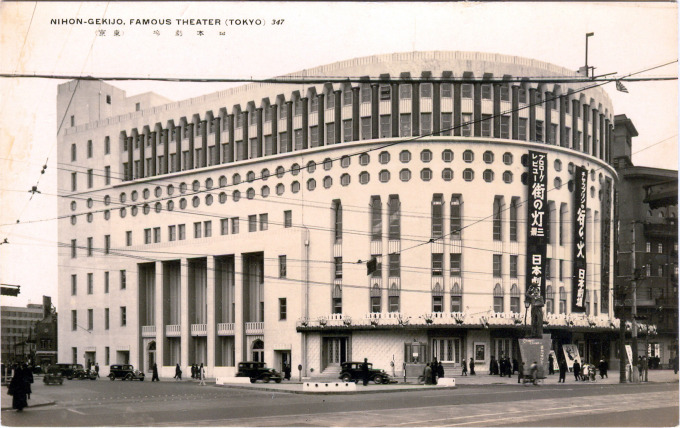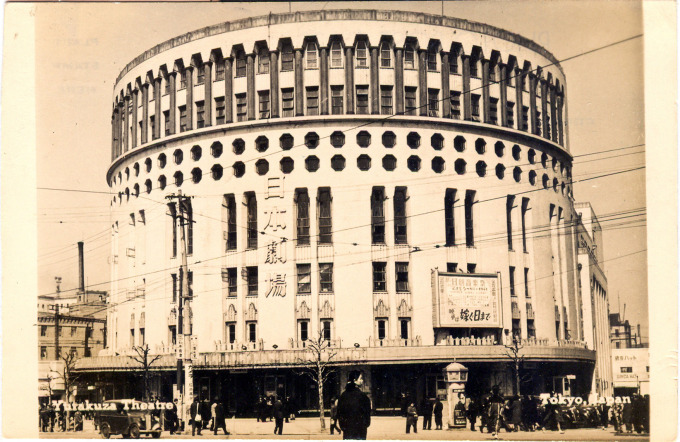“The Nippon Gekijo (“Japan Theater”), colloquially known as Nichigeki, opened in 1933.
“Although it looked circular in appearance from the street, the theater was actually ‘U’-shaped by design. Its Art Deco exterior and interior, comprised of seven stories above and three stories below ground, were designed by Watanabe Hitoshi to accommodate both staged and motion picture entertainment. Said to be patterned after New York’s Roxy, the Nichigeki was planned to be the biggest theater in all Asia with a seating-capacity of four-thousand.
“During World War II, the Nichigeki was one of three large theaters in Tokyo used for the construction and pressure testing of the large paper balloons launched as ‘bombers’ against North America from late 1944. Buildings large enough to house the inflated thirty-three-foot-diameter envelopes were required. After twenty-four hours, each inflated, pressurized balloon was checked for leakage.
“After the war, the Nickgeki became the temporary ‘home’ theater of the Takarazuka (its own theater had been appropriated for use by the Occupation forces). After the Occupation ended in 1952, the Nichigeki reopened with a twin-track box office of burlesque and motion picture features. In 1981, the Nickgeki was shuttered and demolished to make way for redevelopment.”
– Wikipedia
“Even as Japan was about to descend into the maelstrom of the Pacific War, the sweet and ardently romantic strains of Chinese melodies were forcing the military ballads off the hit charts.
“The Ri Koran fever reached its acme on February 1941, when she was to appear on stage at the Tokyo Nichigeki Theater in a show called ‘Koran Sings.’ Multitudes had been gathering from early the evening before, and by the time the doors opened at noon, a line wound around the immense theater building seven and a half times. Police estimates put the number at over a hundred thousand, and they were frankly terrified.
“Elements in the crowd grew unruly, and traffic was being obstructed in the whole region – an unheard-of situation in wartime Japan. Eventually the fire department was called in to turn their hoses on the crowd in order to drive them away from the building. The occurrence is recorded in the history books as the ‘Nichigeki Seven and a Half Times Encirclement Incident.'”
– The Imperial Screen: Japanese Film Culture in the Fifteen Years’ War, 1931-1945, by Peter B. High, 2003
“The Nichigeki Music Hall, whose topless revues delighted American servicemen and tourists for 35 years, turns off its lights this week, the victim of changing tastes and raunchier amusements available in the Japanese capital.
“After high-kicking Mako Misaki, the reigning ‘Queen of Nichigeki,’ gives a final shimmy, shake and wave of the ostrich feathers Saturday, the curtain will close on what was once a must-see attraction for tourists and servicemen.
“A spokesman for the music hall’s producer, the Toho Co., said the theater building opposite the posh and staid Imperial Hotel will be torn down. That will leave Miss Misaki, her 13 fellow topless dancers, a collection of burlesque comics and fully clothed singer Anna Sanjyo without a home.
“But changing tastes, the popularity of home video and a growing sex-oriented entertainment business have left Nichigeki without much of an audience.”
– ‘Topless’ theater closes, victim of permissive times, UPI, March 18, 1981




Pingback: Hattori (Wako) Building, Ginza. | Old Tokyo
Pingback: Tokyo Hotel At Roxy Picture | Accommodation Spot
Pingback: Asahi Shimbun (Newspaper) building, c. 1940, at Sukiyabashi.. | Old Tokyo
Pingback: Aerial Views of Tokyo, c. 1940. | Old Tokyo
Pingback: Asahi Shimbun Building, c. 1930. | Old Tokyo
Pingback: "Bird's Eye View of Tokyo," c. 1960. | Old Tokyo
Pingback: Nikkatsu Hotel, c. 1960. | Old TokyoOld Tokyo
Pingback: Aerial View of Yurakucho Theaters, c. 1935. | Old TokyoOld Tokyo